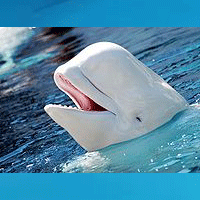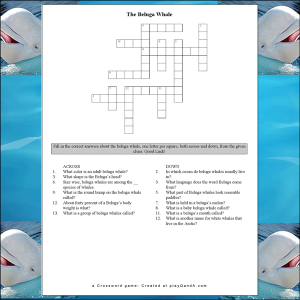Education on safety comes in many forms. This game focuses on safety needed in a school laboratory. Science teachers who have access to a school lab and who have spent time teaching their students about what to and what not to do in a laboratory can use this free game to help reinforce the concepts. The game is a code breaker style game where players first have to decode the answer then match it with a clue. Game time will average around 10 minutes.
Here is some information about the beluga whale:
The beluga whale is a small, toothed whale that is white as an adult. They are found in coastal areas of the Arctic Ocean, and travel south when the sea ice forms.
The beluga’s body is stout and has a small, blunt head with a small beak, tiny eyes and thick layers of blubber. On their head they have a round shape called the melon. This melon holds oil, and the whale is able to change its shape. Scientists believe that it has something to do with the whale’s echolocation system. They have one blowhole. Beluga means white one in Russian. Its genus Delphinapterus, means “whale without fins”, and the species, leucas, means “white”. The beluga is also called the white whale, the white porpoise, the sea canary (because of its songs), and the squid hound (due to its diet). Unlike most other cetaceans, the beluga’s seven neck vertebrae are not fused, giving it a flexible, well-defined neck.
A baby beluga whale, called a calf, is a grey or even brown color when it is born. It will gradually become white over the next five years as it becomes an adult. They grow up to 6.1 m (20 ft) in length and weigh up to 1,361 kg (3,000 lb). They live for between 35 and 50 years of age. A female beluga whale will have one calf every 3 or 4 years. These are born near the coast, often near the entrance to large rivers. The calfs are fed on milk which is 30% fat.
The beluga whales live in groups, called pods of anywhere from only three whales to large groups of more than 200.[4] they can dive down to depths of 800 m (2,625 ft) and stay underwater for as long as 25 minutes.[1] Polar bears and killer whales are known to hunt beluga whales.
Belugas are toothed whales with 34 teeth. The teeth are not designed for chewing, but for grabbing and tearing prey. They swallow their prey whole. They are opportunistic feeders, eating a varied diet of fish, squid, crustaceans, octopi, and worms. They are both benthic (bottom) and pelagic (oceanic) feeders (in shallow water). Belugas sometimes hunt schools of fish cooperatively in small groups.
Like all Play Q and A games the content can be used in another type of game, for example Word Search or Crossword.
The following questions and answers are used in this game
In which ocean do beluga whales usually live in?~Arctic
What language does the word Beluga come from?~Russian
What is the round bump on the beluga whale called?~melon
What color is an adult beluga whale?~White
Size wise, beluga whales are among the __ species of whales.~ smallest
About forty percent of a Beluga’s body weight is what?~Blubber
What is another name for white whales that live in the Arctic?~Beluga
What shape is the Beluga’s head?~Round
What part of Beluga whales look resemble paddles?~ flippers
What is a beluga’s mouth called?~Beak
What is held in a beluga’s melon?~oil
What is a baby beluga whale called?~Calf
What is a group of beluga whales called?~Pods

